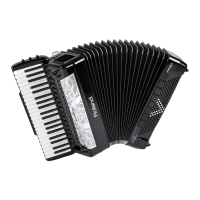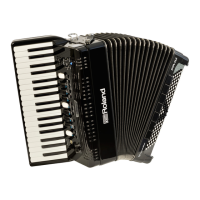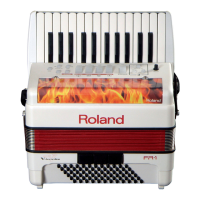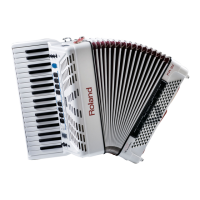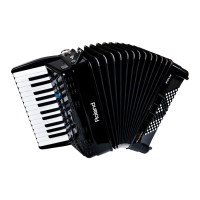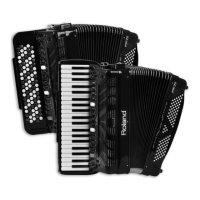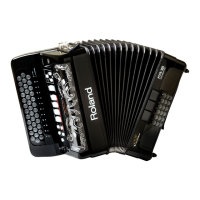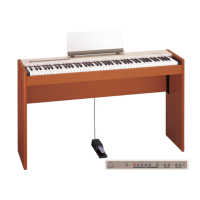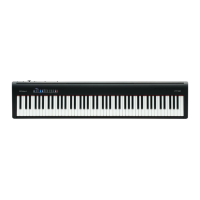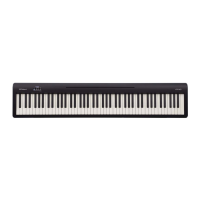Do you have a question about the Roland FR-7 and is the answer not in the manual?
Describes the instrument's ability to produce sound without external amplification.
Highlights the V-Accordion's advanced MIDI controller capabilities.
Explains Roland's technology for realistic sound generation.
Details realistic accordion sounds and electronic benefits.
Discusses controlling external MIDI devices and articulation.
Explains the meaning of WARNING and CAUTION notices.
Defines the meaning of safety symbols used in the manual.
Lists essential precautions for safe operation of the unit.
Guidance on power source, electrical interference, and unit placement.
Instructions for cleaning, data loss during repair, and general care.
General advice for handling, operation, and environmental factors.
Specific safety guidelines for the rechargeable battery.
Details the controls and indicators on the treble section panel.
Details the controls and indicators on the bass section panel.
Explains the function of the display screen and master bar.
Describes the various input and output sockets.
Guidance on connecting the V-Accordion to power and audio devices.
Step-by-step instructions for powering the unit on and off.
How to access and play the built-in demonstration songs.
Overview of the V-Accordion's functional sections (Treble, Bass, etc.).
Guide to switching between basic and advanced parameter access modes.
Explanation of the information displayed on the main operational screen.
How to use the treble keyboard, registers, and volume controls.
How to activate the Sordina function for sound attenuation.
Explanation of Reverb, Chorus, and Delay effects.
How to use the bass buttons, registers, and balance controls.
How to select and use orchestral sounds with the treble keyboard.
Guide to combining orchestral sounds with accordion parts (Solo, Dual, etc.).
Adjusting the volume balance between treble accordion and orchestra sounds.
How to select and use orchestral sounds with the bass buttons.
Changing the musical key of the instrument without altering fingering.
Simulating the 'musette effect' by detuning virtual reeds.
Selecting different temperament systems for musical authenticity.
Adjusting the volume of orchestral sections relative to accordion parts.
Adjusting the volume of virtual valve and button noises.
Explains the role of the FBC-7 as power supply, footswitch, and MIDI interface.
Details the use of footswitches and optional expression pedals.
Information on battery status, charging, and indicator lights.
Step-by-step guide for recharging the battery.
Explains how to select parameters via Jump function and Menu.
Instructions on how to adjust parameter values using the controls.
How to save changes made to tuning parameters.
Adjusting overall pitch and transposing the instrument.
Selecting and customizing tuning systems.
Procedure for saving edited settings for a specific Treble register.
Assigning sounds to reeds and defining register parameters.
Adjusting reed volume, valve noise, and bellows detuning.
Configuring bass/orchestra links and Treble MIDI transmission.
Procedure for saving edited settings for a specific Bass register.
Assigning sounds to reeds and defining Bass register parameters.
Adjusting Bass volume, button noise, reed growl, and bellows detuning.
Procedure for saving edited settings for a specific Free Bass register.
Assigning sounds to reeds and defining Free Bass register parameters.
Procedure for saving edited settings for Orchestra Bass registers.
Setting the lowest playable note and note release time.
Procedure for saving edited settings for Orchestra section parameters.
Adjusting octave, volume, and bellows detuning for orchestral sounds.
Procedure for saving settings that apply to all sections within a Set.
Setting global parameters for Reverb, Chorus, and Delay effects.
Procedure for saving global system-wide settings.
Adjusting display contrast and selecting parameter access modes.
Configuring bellows response and assigning functions to FBC-7 footswitches.
Settings for bass modes, stereo image, and automatic power saving.
Checking the current battery level and charging status.
Functions for copying effect settings and restoring factory defaults.
Introduction to MIDI, its purpose, and how it works.
Explains how to connect the FR-7/FR-5 to external MIDI devices.
Guidance on using the instrument with sequencers for recording.
Setting MIDI channels for different instrument parts.
Disabling MIDI data transmission from specific sections.
Addressing issues with MIDI data transmission and buffer overflow.
Steps to access and configure MIDI parameters for each section.
Details on MIDI parameters like Octave, CC, Volume, Pan, Reverb, Chorus.
Procedure for transmitting settings to external devices using SysEx.
Procedure for receiving settings from external devices.
How to save edited parameters using the WRITE function.
Procedure to reset the instrument to its original factory settings.
Solutions for problems related to sound output and volume.
Troubleshooting parameter selection and section activation issues.
Solutions for MIDI communication and data saving errors.
Technical details including keyboards, sound source, and effects.
List of included items and optional accessories.
Details on MIDI messages the FR-7/FR-5 can receive.
Details on MIDI messages the FR-7/FR-5 can transmit.
| rated power | 2 x 25W RMS |
|---|---|
| battery capacity | 24V-4500mAh |
| battery type | Rechargeable Ni-MH battery pack |
| display resolution | 48 x 84 dots |
|---|---|
| speakers | 10 cm x 2 speakers |
| tweeters | 2 |
| size | 405 (H) x 506 (W) x 270 (D) mm |
|---|---|
| weight | 11.7 kg with battery, without straps |
| battery type | Rechargeable Ni-MH battery pack (optional) |
|---|
| display resolution | 48 x 84 dots |
|---|
| size | 405 (H) x 506 (W) x 270 (D) mm |
|---|---|
| weight | 9.5 kg without optional battery, without straps |
| rated power | 2 x 11W RMS |
|---|---|
| power supply | External AC adapter (100V~240V universal) |
| speakers | 2 x 10cm speakers (Neodymium transducer magnets) |
|---|
| size | 387 (H) x 472 (W) x 240 (D) mm |
|---|---|
| weight | 8.25 kg without optional batteries, without straps |
| rated power | 2 x 11W RMS |
|---|---|
| power supply | External AC adapter (100V~240V universal) |
| speakers | 2 x 10cm speakers (Neodymium transducer magnets) |
|---|
| size | 387 (H) x 472 (W) x 240 (D) mm |
|---|---|
| weight | 8.25 kg without optional batteries, without straps |
| power supply | External AC adapter (100V~240V universal) |
|---|
| max polyphony | 64 voices |
|---|
| size | 387 (H) x 472 (W) x 240 (D) mm |
|---|---|
| weight | 7.5 kg without optional batteries, without straps |
